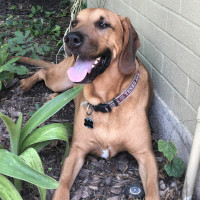Appearance of the Labloodhound
|
| A large, athletic dog, the Labloodhound generally adopts the best physical traits of each parent, making it a successful athlete. Their bodies are large and muscular, with adults weighing between 31 and 45 kg and heights ranging from 53 to 63 cm. Their powerful bodies and muscular limbs provide both speed and endurance. While the Labloodhound may not have the remarkably long ears and adorably drooping skin of the St. Hubert's Hound, many certainly have larger-than-average hanging ears and those same melancholy brown eyes. The Labloodhound's big black nose is clearly visible on their face. Some skin folds around the head and neck are possible, although they are rarely seen to the same extent as in a pure-bred St. Hubert. The Labloodhound's tail is long and slender, often carried straight or in the air. The Labloodhound's coat is short and dense, with brown, black or a mixture of both. White patches on the coat are not uncommon, and many will have patches on the neck and legs. |
Temperament of the Labloodhound
|
| As any Labrador Retriever owner will tell you, they're a friendly breed. Although the Labloodhound is generally slightly more reserved than its parent, it is well-rounded and social. Some will be wary of strangers and will need good socialization from an early age if they are to tolerate guests in the home. As far as their own family is concerned, Labloodhounds are a breed to be trusted and are renowned for being docile and good-natured with children, often behaving like a child-minding dog. Frustratingly, behavior problems are not uncommon in under-stimulated Labloodhounds. They are a breed in their own right and like to stay active and busy. Dogs left alone at home for long periods may well develop undesirable vices, such as howling and digging behaviors. This can be avoided by ensuring that these dogs receive plenty of exercise and remain mentally motivated. The characteristic barking and howling of the St. Hubert's Hound is usually passed on to the Labloodhound, which will make a lot of noise to alert its owner to any new activity. While this makes them superb watchdogs, it can become a problem if you live in an urban area. |
Needs and activities of the Labloodhound
|
| A Labloodhound will be an energetic dog needing regular daily exercise to keep fit and prevent the formation of bad habits. They'll enjoy long walks and runs and are likely to enjoy swimming, so they'll love going to the beach. Ball games are a good idea to help burn off excess energy. If they're exercised in a public place, you'll need to keep an eye on them as they roam to find an interesting scent. These dogs are best suited to a house with a fenced-in yard, not an apartment, as they are large and need space. With their dense coats, it's not advisable to exercise your pet in the heat of the day, but rather in the early morning or late evening. |
Maintenance of the Labloodhound
|
| Labloodhounds have dense coats and don't shed much, so they're low-maintenance when it comes to grooming. They do well with occasional brushing, but need regular cleaning of their skin folds to prevent skin problems. With both parent breeds prone to ear infections, it will be crucial to check your dog's ears regularly and clean them to avoid any build-up of dirt. It's always a good idea to get into the habit of brushing his teeth regularly. This breed is likely to chew a lot, so it will be important to check for cracked teeth. It's also important to check the nails to see if they need trimming. |









 English (United Kingdom)
English (United Kingdom)